|
Chapter Thirteen
ABRAHAM: THE
FATEFUL YEARS
And it came to pass
in the days of Amraphel king of Shin’ar,
Ariokh king of Ellasar,
Khedorla’omer king of Elam,
and Tidhal king of Go’im -
That these made war
with Bera King of Sodom,
and with Birsha king of Gomorrah,
Shinab king of Admah,
and Shem-eber king of Zebi’im,
and with the king of Bela, which is Zoar.
"Thus begins the biblical tale, in chapter 14 of Genesis, of an
ancient war that pitted an alliance of four kingdoms of the East
against five kings in Canaan. It is a tale that has evolved some of
the most intense debate among scholars, for it connects the story of
Abraham, the first Hebrew Patriarch, with a specific non-Hebrew
event, and thus affords objective substantiation of the biblical
record of the birth of a nation.
"....For many decades the critics of the
Old Testament seemed to
prevail; then, as the nineteenth century was drawing to a close, the
scholarly and religious worlds were astounded by the discovery of
Babylonian tablets naming Khedorla’omer, Ariokh, and
Tidhal in a
tale not unlike the biblical one.
"The discovery was announced in a lecture by
Theophilus Pinches to
the Victoria Institute, London, in 1897. Having examined several
tablets belonging to the Spartoli Collection in the British Museum,
he found that they describe a war of wide-ranging magnitude, in which
a king of Elam, Kudur-laghamar, led an alliance of rulers that
included one named Eri-aku and another named Tud-ghula - names that
easily could have been transformed into Hebrew as Khedor-la’omer,
Ariokh, and Tidhal. Accompanying his published lecture with a
painstaking transcript of the cuneiform writing and a translation
thereof, Pinches could confidently claim that the biblical tale had
indeed been supported by an independent Mesopotamian source.
"With justified excitement the
Assyriologists of that time agreed
with Pinches reading of the cuneiform names. The tablets indeed
spoke of "Kudur-Laghamar, king of the land of Elam"; all scholars
agreed that it was a perfect Elamite royal name, the prefix
Kudur
("Servant") having been a component in the names of several
Elamite
kings, and Laghamar being the Elamite epithet-name for a certain
deity. It was agreed that the second name, spelled Eri-e-a-ku in the
Babylonian cuneiform script, stood for the original Sumerian ERI.AKU,
meaning "Servant of the god Aku," Aku being a variant of the name of
Nannar/Sin. It is known from a number of inscriptions that
Elamite
rulers of Larsa bore the name "Servant of Sin," and there was
therefore little difficulty in agreeing that the biblical Eliasar,
the royal city of the king Ariokh, was in fact Larsa. There was also
unanimous agreement among the scholars for accepting that the
Babylonian text’s Tud-ghula was the equivalent of the biblical "Tidhal,
king of Go’im"; and they agreed that by Go’im the
Book of Genesis
referred to the "nation-hordes" whom the cuneiform tablets listed as
allies of Khedorla’omer.
"Here, then, was the missing proof - not only of the veracity of the
Bible and of the existence of Abraham, but also of an international
event in which he had been involved!
"....The second discovery was announced by
Vincent Scheil, who
reported that he had found among the tablets in the Imperial Ottoman
Museum in Constantinople a letter from the well-known Babylonian
King Hammurabi, which mentions the very same Kudur-laghamar! Because
the letter was addressed to a king of Larsa, Father Scheil concluded
that the three were contemporaries and thus matched three of the
four biblical kings of the East - Hammurabi being none other than "Amraphael
king of Shin’ar."
"....However, when subsequent research convinced most
scholars that
Hammurabi reigned much later (from 1792 to 1750 B.C., according to
The Cambridge Ancient History), the synchronization seemingly
achieved by Scheil fell apart, and the whole bearing of the
discovered inscriptions - even those reported by Pinches - came into
doubt. Ignored were the pleas of Pinches that no matter with whom
the three named kings were to be identified - that even if Khedorla’omer,
Ariokh, and Tidhal of the cuneiform texts were not
contemporaries of Hammurabi - the text’s tale with its three names
was still "a remarkable historical coincidence, and deserves
recognition as such." In 1917, Alfred Jeremias (Die sogenanten
Kedorlaomer-Texte) attempted to revive interest in the subject; but
the scholarly community preferred to treat the Spartoli tablets with
benign neglect.
"....Yet the scholarly consensus that the biblical tale and the
Babylonian texts drew on a much earlier, common source impels us to
revive the plea of Pinches and his central argument: How can
cuneiform texts, affirming the biblical background of a major war
and naming three of the biblical kings, be ignored? Should the
evidence - crucial, as we shall show, to the understanding of
fateful years - be discarded simply because Amraphel was not
Hammurabi?
"The answer is that the Hammurabi letter found by
Scheil should not
have sidetracked the discovery reported by Pinches, because
Scheil misread the letter. According to his rendition,
Hammurabi promised a
reward to Sin-Idinna, the king of Larsa, for his "heroism on the day
of Khedorla’omer." This implied that the two were allies in a war
against Khedorla’omer and thus contemporaries of that king of Elam.
It was on this point that
Scheil’s find was discredited, for it
contradicted both the biblical assertion that the three kings were
allies and known historical facts: Hammurabi treated Larsa not as an
ally but as an adversary, boasting that he "overthrew Larsa in
battle," and attacked its sacred precinct "with the mighty weapon
which the gods had given him."
"A close examination of the actual text of
Hammurabi’s letter
reveals that in his eagerness to prove the Hammurabi-Amraphel
identification, Father Scheil reversed the letter’s meaning:
Hammurabi was not offering as a reward to return certain goddesses
to the sacred precinct (the Emutbal) of Larsa; rather, he was
demanding their return to Babylon from Larsa.
"....The incident of the
abduction of the goddesses had thus
occurred in earlier times; they were held captive in the Emutbal
"from the days of Khedorla’omer"; and Hammurabi was now demanding
their return to Babylon, from where Khedorla’omer had taken them
captive. This can only mean that Khedorla’omer’s days were long
before Hammurabi’s time.
"Supporting our reading of the
Hammurabi letter found by Father Scheil in the Constantinople Museum is the fact that
Hammurabi
repeated the demand for the return of the goddesses to Babylon in
yet another stiff message to Sin-Idinna, this time sending it by the
hand of high military officers. This second letter is in the British
Museum (No. 23,131) and its text was published by L.W. King in
The
Letters and Inscriptions of Hammurabi.
"....That the goddesses were to be returned from
Larsa to Babylon is
made clear in the letter’s further instructions.
"....It is thus clear from these letters that
Hammurabi - a foe, not
an ally, of Larsa - was seeking restitution for events that had
happened long before his time, in the days of Kudur-Laghamar, the
Elamite regent of Larsa. The texts of the Hammurabi letters thus
affirm the existence of Khedorla-omer and of Elamite reign in Larsa
("Ellasar") and thus of key elements in the biblical tale.
"Which is the period into which these key elements fit?
|
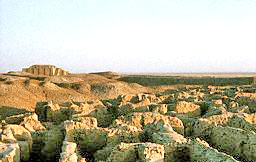
Desert view
of ruins of ancient city of Ur, where it is believed
Abraham was born
.
|
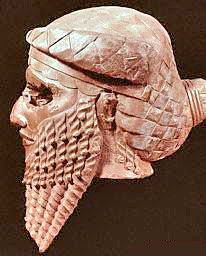
Some
attribute this sculpture to Sargon, the Akkadian King
who ruled in UR, the home-place of Abraham.
|
|
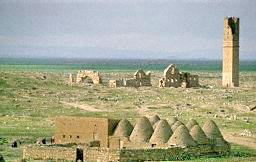
Harran
today, amidst ruins. The city where Abraham and his
family migrated from UR, before they continued to Canaa.
|
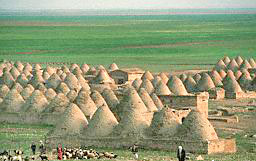
|
|
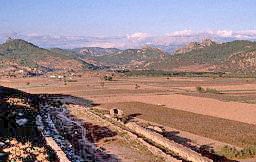
Taurus
Mountains, a crossroads in antiquity, Harran situated at
its foothills. The people worshipped Nannar/Sin
.
|
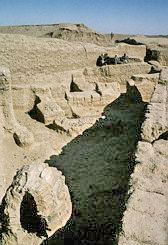
Ancient
ruins of Mari, (right) another gateway which was used by
Marduk’s emissaries to supply his followers in Babylon,
while he was in exile. Marduk was the reason why Abraham
hurried to Canaan. |
|
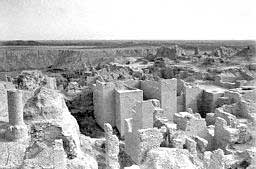
Ruins of
Babylon, where Marduk was worshipped
.
|

Bethel,
where Yahweh spoke to Abraham. Abraham kept
returning to that spot, close to Mount Moriah (Mount of
Directing) close to Jerusalem. |
|
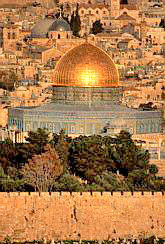
Mount Moriah,
upon whose Sacred Rock the Ark of the Covenant was
placed when Solomon built the Temple of Yahweh.
|
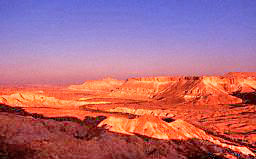
From Mount
Moriah, Abraham went to the Negev Desert, where Canaan
and the Sinai peninsula merge...
.
|
|

Abraham was
directed to Negev and his focus was Mount Moriah, Mount
Zophim and Mount Zion (right), as the site of Mission
Control Center of the Anunnaki: it was the gateway to
the Spaceport in the Sinai. |

. |
|
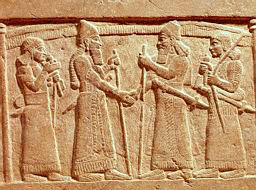
Shalmaneser
III, receiving a Babylonian King in Damascus.
|
|
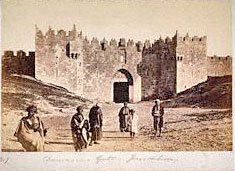
Damascus
Gate
Josephus
records Abraham as having "reigned" in Damascus as a
foreigner
|
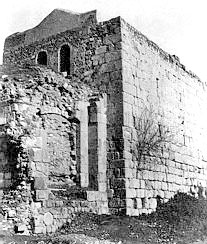
Ancient part
of a wall in Damascus |
|
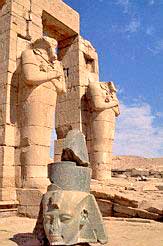
Abraham
arrived to Egypt when it was divided, with Thebes in the
south being followers of the god Amun "The Hiding God"
Ra/Marduk....
Ramasseum Temple dedicated to Ra and Amun, at Thebes.
Lower Egypt (norhtern), were not followers of such god. |
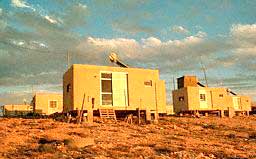
Kadesh
Barnea (today) the closest spot Man could approach on
the way to the Spaceport. Abraham and his army had been
commanded to guard it and was able to repell the
invaders
.
|
|
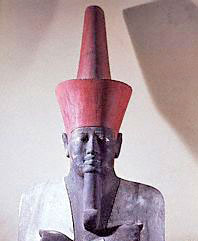
In Egypt,
Pharaoh Mentuhotep II, leader of the Theban Princes
defeated the northern Pharaohs. |
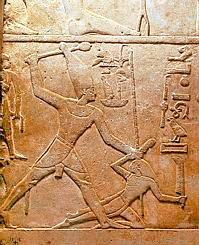
|
"As historical records
have established, it was Shulgi who in the twenty-eighth year of his
reign (2068 B.C.) gave his daughter in marriage to an Elamite
chieftain and granted him the city of Larsa as a dowry; in return
the Elamites put a "foreign legion" of Elamite troops at
Shulgi’s
disposal. These troops were used by Shulgi to subdue the western
provinces, including Canaan. It is thus in the last years of
Shulgi’s reign that when Ur was still an imperial capital under his
immediate successor Amar-Sin that we find the historical time slot
into which all the biblical and Mesopotamian records seem to fit
perfectly.
"It is in that time, we believe, that the search for the historical
Abraham should be conducted; for - as we shall show - the tale of
Abraham was interwoven with the tale of the fall of
Ur, and his days
were the last days of Sumer.
"With the discredit of the
Amraphel-Hammurabi notion, the
verification of the Age of Abraham became a free-for-all, some
suggesting such late dates that made the first patriarch a
descendant of the later kings of Israel... But the exact dates
of his time and events need no guessing: the information is provided
by the Bible itself; all we have to do is accept its veracity.
Mr. Sitchin at this point goes into great extent researching,
comparing his findings with those of other scholars, historians of
ancient and later years; he performs a genealogy of kings from King
Solomon backwards, reaches the Pharaohs of the times before and
during the Exodus of the Israelites, verifies the expulsion of the
Hyksos (Asiatic "Shepherd Kings") in 1567 B.C. by the founder of the
eighteenth dynasty, and further back until he reaches the birth of
Abraham in 2123 B.C. Then Mr. Sitchin continues:
"....The century of
Abraham - the hundred years from his birth to
the birth of his son and successor Isaac - was thus the century that
witnessed the rise and fall of the Third Dynasty of Ur. Our reading
of biblical chronology and tales puts Abraham in the middle of the
momentous events of that time, not as a mere observer but as an
active participant.
"....In spite of numerous studies concerning
Abraham, the fact
remains that all we know about him, is what we find in the Bible.
Belonging to a family that traced its ancestry to the line of Shem,
Abraham - then called Abram - was the son of Terah, his brothers
being Harran and Nahor. When Harran died at an early age, the family
was living in "Ur of the Chaldees." There, Abram married
Sarai
(later renamed Sarah).
"Then "did Terah take
Abram his son and Lot his grandson, the son of Harran, and
Sarai his daughter-in-law the wife of Abram his son; and
they left and went forth from Ur of the Chaldees to go to the land
of Canaan; and they went as far as Harran, and dwelt there."
"Archaeologists have found Harran ("The Caravanry"). Situated to the
northeast of Mesopotamia at the foothills of the Taurus Mountains,
it was a major crossroads in antiquity.
As Mari controlled the southern gateway from
Mesopotamia to the
lands of the Mediterranean coast, so did Harran controlled the
gateway of the northern route to the lands of Western Asia. Marking,
at the time of the Third Dynasty of Ur, the limits of Nannar’s
domains where they bordered on Adad’s Asia Minor, Harran was found
by the archaeologists to have been a mirror image of Ur in its
layout and in its worship of Nannar/Sin.
"No explanation is given in the bible for leaving
Ur, and there is
also no time stated, but we can guess the answer if we relate the
departure to events in Mesopotamia in general and in
Ur in
particular.
"We know that Abraham was seventy-five when he proceeded later on
from Harran to Canaan. The tenor of the biblical narrative suggests
a long stay at Harran and depicts Abraham on his arrival there as a
young man with a new bride. If Abraham, as we have concluded, was
born in 2123 B.C., he was a child of ten when Ur-Nammu ascended the
throne in Ur, when Nannar was favored for the first time with the
trusteeship over Nippur. And he was a young man of twenty-seven when
Ur-Nammu inexplicably fell from Anu’s and Enlil’s favor, slain on a
distant battlefield. We have described the traumatic effect of the
event on the people of Mesopotamia, the shock it had given to their
faith in Nannar’s omnipotence and the fidelity of Enlil’s word.
"The year of Ur-Nammu’s fall was 2096 B.C., could it not have been
the year when - under the impact of the event or as a consequence
thereof - Terah and his family left Ur for a faraway designation,
stopping off at Harran, the Ur away from Ur?
"All through the following years of
Ur’s decline and Shulgi’s
profanities, the family stayed on in Harran. Then, suddenly, the
Lord acted again:
And Yahweh said unto Abram:
"Get thee out of thy country
and out of thy birthplace
and from thy father’s house,
unto the land which I will show thee". . .
And Abram departed as Yahweh had spoken unto him,
and Lot went with him.
And Abram was seventy-five years old when he left Harran.
"Once again, no reason is given for the crucial move. But the
chronological clue is most revealing. When Abraham was seventy-five
years old the year was 2048 B.C. - the very year of Shulgi’s
downfall!
"Because Abraham’s family (Genesis 11) directly continued the
line
of Shem, Abraham has been considered a Semite, on whose background,
cultural heritage, and language were Semitic, as distinct (in
scholars’ minds) from the non-Semitic Sumerians and the later
Indo-Europeans. But in the original biblical sense, all the peoples
of greater Mesopotamia were descended of Shem, "Semite" and
"Sumerian" alike. There is nothing in the Bible that suggests - as
some scholars have begun to hold - that Abraham and his family were
Amorites (i.e., western Semites) who had come as immigrants to
Sumer
and then returned to their original abode. On the contrary: There is
everything to support the image of a family rooted in Sumer from its
earliest beginnings, hastily uprooted from its country and
birthplace and told to go to an unfamiliar land.
"The correspondence between two biblical events with the dates of
two major Sumerian events - and of more to come - must serve as
indication of a direct connection between them all. Abraham emerges
not as the son of immigrant aliens but as the scion of a family
directly involved in Sumerian affairs of state!
In their search for the answer to the question of "Who Was Abraham,"
scholars have seized upon the similarity his designation as a Hebrew
(Ibri) and the term Hapiru (which in the Near East could transform
to Habiru) by which the Assyrians and Babylonians in the eighteenth
and seventeenth centuries B.C. called bands of pillaging western
Semites. At the end of the fifteenth century B.C., the commander of
an Egyptian garrison in Jerusalem asked his king for reinforcements
against approaching Hapiru.
Scholars have taken all that as evidence
for the notion that Abraham was a western Semite.
"Many scholars doubt, however, whether the term denotes an ethnic
group at all, wondering whether the word was not a descriptive noun
simply meaning "marauders" or "invaders."
The suggestion that
Ibri (clearly from the verb "to cross") and
Hapiru are one and the same entails substantial philological and
etymological problems. There are also chronological inconsistencies,
all which gave rise to serious objections to this suggested solution
for the identity of Abraham, especially when the biblical data is
compared with the "bandit" connotation of the term
Hapiru. Thus the
Bible relates incidents concerning water wells, which shows that
Abraham was careful to avoid conflict with local residents as he
journeyed through Canaan. When Abraham became involved in the
War of
he Kings, he refused to share in the booty. This is not the behavior
of a marauding barbarian but rather of a person of high standards of
conduct. Coming to Egypt, Abraham and Sarah were taken to the
Pharaoh’s court; in Canaan, Abraham made treaties with the local
rulers.
This is not the image of a nomad pillaging other’s
settlements; it is the image of a personage of high standing skilled
in negotiation and diplomacy.
"....The Old Testament,
in fact (Genesis 17: 1-6), provides us with the time and manner in
which Abraham was transformed from a Sumerian nobleman to a west
Semitic potentate, under a covenant between he and his God. Amid a
ritual of circumcision, his Sumerian name AB.RAM ("Father’s
Beloved") was changed to the Akkadian/Semitic Abraham ("Father of a
Multitude of Nations") and that of his wife SARAI ("Princess") was
adapted to the Semitic Sarah.
It was only when he was ninety-nine years old that
Abraham became a
"Semite."
"....Is it not naive to assume that for
the Mission to Canaan, for
the birth of a nation, and for kinship over all the lands from the
border of Egypt to the border of Mesopotamia, the
Lord would choose
someone at random, picking up anyone, in the streets of Ur? The
young woman whom Abraham married bore the epithet-name Princess;
since she was a half-sister of Abraham ("Indeed she is my sister,
the daughter of my father but not the daughter of my mother"), we
can take it for granted that either Abraham’s father or Sarah’s
mother was of royal descent. Since the daughter of Harran,
Abraham’s
brother, also bore royal name (Milkha - "Queenly"), it follows that
it was through the father of Abraham that the royal ancestry flowed.
In dealing with Abraham’s family we thus deal with a family of
Sumer’s highest echelons; people of a noble deportment and elegant
dress as found depicted on various Sumerian statues.
"It was a family that not only could claim
descent from Shem but
which kept family records tracing its lineage through generations of
first born sons: Arpakhshad and Shelach and Eber; Peleg, Re’u and
Serug; Nahor and Terah and Abraham, taking the family’s recorded
history back for no less than three centuries!
"....But of greatest interest, to this very day, has been the
meaning of the name Eber and the reason for bestowing it upon the
firstborn in 2351 B.C. and from which has stemmed the biblical term
Ibri ("Hebrew") by which Abraham and his family identified
themselves. It clearly stems from the root word meaning "to cross,"
and the best scholars had to offer in explanation was to seek the
Habiru/Hapiru connection, which we have already mentioned (and
discarded). This erroneous interpretation has stemmed from the
search for the meaning of the epithet-name in Western Asia. It is
our conviction that instead the answer is to be found in the
Sumerian origins and the Sumerian language of Abraham and his
ancestors. Such a look at the Sumerian roots of the family and the
name provides an answer that startles for its simplicity.
"The term
Ibri ("Hebrew").... clearly stemmed from
Eber, the father
of Peleg, and from the root "to cross."
"The biblical suffix
"i" when applied to a person, meant "a native
of"; Gileadi meant a native of Gilead and so on. Likewise,
Ibri
meant a native of the place called "Crossing"; and that, precisely,
was the Sumerian name for Nippur: NI.IB.RU - the Crossing Place, the
place where the pre-Diluvial grids crisscrossed each other, the
original Navel of the Earth, the olden
Mission Control Center.
"The dropping of the n in transposing from
Sumerian to Akkadian/Hebrew was a frequent occurrence. In stating that
Abraham
was an Ibri, the Bible simply meant that Abraham
was a Ni-ib-ri, a
son of Nippurian origin!
"The fact that Abraham’s family migrated to
Harran from Ur has been
taken by scholars to imply that Ur was Abraham’s birthplace, but
that is not stated anywhere in the Bible. On the contrary, the
command to Abraham to go to Canaan and leave for good his past
abodes lists three separate entities:
-
his father’s house (which was
then in Harran)
-
his land (the city-state of Ur)
-
his birthplace
(which the Bible does not identify)
Our suggestion that
Ibri means
a native of Nippur solves the problem of Abraham’s true birthplace.
"As the name Eber indicates, it was in this time - the middle of the
twenty-fourth century B.C - that the family’s association with
Nippur had begun. Nippur was never a royal capital; rather,
it was a
consecrated city, Sumer’s "religious center," as scholars put it. It
was also the place where the knowledge of astronomy was entrusted to
the high priests and thus the place where the calendar - the
relationship between the Sun, and Moon in their orbits - was
originated.
"Scholars have recognized that our present-day calendars derive from
the original Nippurian calendar. All the evidence shows that the
Nippurian calendar began circa 4000 B.C., in the
age of Taurus.
"In this we find yet another confirmation of the umbilical cord
connecting the Hebrews with Nippur: The Jewish calendar still
continues to count the years from an enigmatic beginning in 3760
B.C. (so that in 1983 the Jewish year was 5743). It had been assumed
that this is a count "from the beginning of the world"; but the
actual statement by Jewish sages was that this is the number of
years that had passed "since counting [of years] began." We suggest
that it means, since the introduction of the calendar in Nippur.
"In the ancestral family of Abraham we thus find a priestly family
of royal blood, a family headed by a Nippurian high priest who was
the only one allowed into the temple’s innermost chamber, there to
receive the deity’s word and convey it to king and people.
"In this regard the name of
Abraham’s father, Terah, is of great
interest. Seeking clues only in the Semitic environment, biblical
scholars regard the name, as those of Harran and
Nahor, as mere
toponyms (names that personify places) holding that there were
cities by such names in central and northern Mesopotamia.
Assyriologists searching the Akkadian terminology (being the first
Semitic language) could only find that Tirhu meant "an
artifact or
vessel for magical purposes." But if we turn to the Sumerian
language, we find that the cuneiform sign for Tirhu stemmed directly
from that of an object called in Sumerian DUG.NAMTAR - literally, a
"Fate Speaker" - a Pronouncer of Oracles!
"Terah, then, was an Oracle Priest, one assigned to approaching the
"Stone that Whispers" to hear the deity’s words and communicate them
(with or without an interpretation) to the lay hierarchy. It was a
function assumed in later times by the Israelite High Priest, who
alone was allowed to enter the Holy of Holies, approach the
Dvir
("Speaker"), and "hear the voice [of the Lord] speak unto him from
off the overlay which is upon the Ark of the Covenant, from between
the two Cherubim." During the Israelite Exodus, at
Mount Sinai the
Lord proclaimed that his covenant with the descendants of Abraham
meant that "ye shall be unto me a kingdom of priests." It was a
statement that reflected the status of Abraham’s own descent:
a
royal priesthood.
"....Votive inscriptions found at
Nippur (as those by the
archaeological expeditions of the University of Pennsylvania)
confirmed that the kings of Ur cherished the title "Pious Shepherd
of Nippur" and performed there priestly functions; and the governor
of Nippur (PA.TE.SI.NI.IB.RU) was also the Foremost UR.ENLIL
("Enlil’s Foremost Servant").
"Some of the names borne by these royal-priestly VIPs resembled
Abraham’s Sumerian name (AB.RAM), also beginning with the
component AB ("Father" or "Progenitor"); such, for example, was the name
AB.BA.MU of a governor of Nippur during Shulgi’s reign.
"....From
Hittite friendship (residents of Canaan), who were known
for their military experience, may shed light on the question of
where Abraham himself had acquired the military proficiency which he
employed so successfully during the War of the King.
"Ancient traditions also depict
Abraham as greatly versed on
astronomy - a knowledge then valuable for long journeys guided by
the stars. According to Josephus, Berossus referred to
Abraham,
without naming him, when he wrote of the rise "among the Chaldeans,
of a certain righteous and great man who was well seen in
astronomy." (If Berossus, the Babylonian historian, had indeed
referred to Abraham, the significance of the inclusion of the Hebrew
Patriarch in Babylonian Chronicles far exceeds the mere notation of
his knowledge of astronomy).
"All during the
ignominious years of Shulgi’s reign, the family of Terah stayed at
Harran. Then, on Shulgi’s demise, the divine order came to proceed
to Canaan. Terah was already quite old, and
Nahor, his son, was to
stay on with him in Harran. The one chosen for the mission was
Abraham - himself a mature man of seventy-five. The year was 2048
B.C.; it marked the beginning of twenty-four fateful years -
eighteen years encompassing the war-filled reigns of the two
immediate successors of Shulgi (Amar-Sin and Shu-Sin) and six years
of Ibbi-Sin, the last sovereign king of Ur.
"It is undoubtedly more than mere coincidence that
Shulgi’s death
was the signal not only for a move by Abraham, but also for a
realignment among the Near Eastern gods. It was exactly when
Abraham, accompanied (as we learn later) by an elite military corps,
left Harran - the gateway to the Hittite lands - that the exiled and
wandering Marduk appeared in "Hatti land." Moreover, the remarkable
coincidence is that Marduk stayed there through the same twenty-four
Fateful Years, the years that culminated with the great Disaster.
"The evidence for Marduk’s movements is a tablet found in the
library of Ashurbanipal, in which an aging Marduk tells of his
erstwhile wanderings and eventual return to Babylon.
"....We learn from the balance of the text that
Marduk sent from his
new place in exile (Asia Minor) emissaries and supplies (via Harran)
to his followers in Babylon, and trading agents into
Mari, therefore
making inroads into both gateways - the one beholden to Nannar/Sin
and the other Inanna/Ishtar.
"As on a signal, with the death of
Shulgi, the whole ancient world
came astir. The House of Nannar had been discredited, and the
House
of Marduk saw its final prevailing hour approaching. While Marduk
himself was still excluded from Mesopotamia, his first born son,
Nabu, was making converts to his father’s cause.... His efforts
encompassed all the lands, including Greater Canaan.
"It was against this background of fast developments that
Abraham
was ordered to go to Canaan. Though silent concerning
Abraham’s
mission, the Old Testament is clear regarding his destination:
Moving expeditiously to Canaan, Abraham and his wife, his nephew
Lot, and their entourage continued swiftly southward. There was a
stopover at Shechem, where the Lord spoke to Abraham. "Then he
removed from there to the Mount, and encamped east of Beth-El; and
he built there an altar to Yahweh and called the name of Yahweh."
Beth-El whose name meant "God’s House" - a site to which
Abraham
kept coming back - was in the vicinity of Jerusalem and its hallowed
Mount, Mount Moriah ("Mount of Directing"), upon whose
Sacred Rock
the Ark of the Covenant was placed when Solomon built the temple of
Yahweh in Jerusalem.
"From there "Abram journey farther, still going toward the
Negev."
The Negev - the dry region where Canaan and the
Sinai peninsula
merge - was clearly Abraham’s destination.
"....What was
Abraham to do in the Negev, whose very name ("The
Dryness") bespoke its aridity? What was there that required the
patriarch’s hurried, long journey from Harran and impelled his
presence among the miles upon miles of barren land?
"The significance of
Mount Moriah - Abraham’s first focus of
interest - was that in those days it served, together with its
sister mounts Mount Zophim ("Mount of Observers") and
Mount Zion
("Mount of Signal"), as the site of Mission Control Center of the
Anunnaki. The significance of the Negev, its only significance, was
that it was the gateway to the Spaceport in the Sinai.
"Subsequent narrative informs us that
Abraham had military allies in
the region and that his entourage included an elite corps of several
hundred fighting men. The biblical term for them - Naar - has been
variously translated as "retainer" or simply "young man"; but
studies have shown that in Hurrian the word denoted riders or
cavalrymen. In fact, recent studies of Mesopotamian texts dealing
with military movements list among the men of the chariots and the
cavalry LU.NAR ("Nar-men") who served as fast riders. We find an
identical term in the Bible (I Samuel 30:17): after King David
attacked an Amalekite camp, the only ones to escape were "four
hundred Ish-Naar" - literally, "Nar-men" or
LU.NAR - "who were
riding the camels."
"....The emerging image of
Abraham not as a shepherding nomad but as
an innovative military commander of royal descent may not fit the
customary image of this Hebrew patriarch, but it is in accord with
ancient recollections of Abraham. Thus, quoting earlier sources
concerning Abraham, Josephus, (first century A.D.) wrote of him:
"Abraham reigned at Damascus, where he was a foreigner, having come
with an army out of the land above Babylon" from which, "after a
long time, the Lord got him up and removed from that country
together with his men and he went to the land then called the land
of Canaan but now the land of Judaea."
"The mission of
Abraham was a military one: to protect the space
facilities of the Anunnaki - the Mission Control Center and the
Spaceport!
"After a short stay in the Negev
Abraham traversed the Sinai
peninsula and came to Egypt. Evidently no ordinary nomads.
Abraham
and Sarah were at once taken to the royal palace. By our reckoning
the time was circa 2047 B.C., when the Pharaohs then ruling in
Lower
(northern) Egypt who were not followers of Amen ("The Hiding God"
Ra/Marduk") were facing a strong challenge from the
princes of
Thebes in the south, where Amen was deemed supreme. We can only
guess what matters of state - alliances, joint defenses, divine
commands - were discussed between the beleaguered Pharaoh and the
Ibri, the Nippurian general. The Bible is silent on this as well as
on the length of stay. (The Book of Jubilees states that the sojourn
lasted five years). When the time came for Abraham to return to the
Negev, he was accompanied by a large retinue of the
Pharaoh's men.
"....Abraham went on to the hill country, settling on the highest
peak near Hebron, from where he could see in all directions; and the
Lord said unto him: "Go, cross the country in the length and breadth
of it, for unto thee shall I give it."
Mr. Sitchin at this point researches more dates of events and
summarizes on the following chart:
-
2123 B.C.
- Abraham born in Nippur to his father Terah.
-
2113 B.C.
- Ur-Nammu enthroned in Ur, given guardianship of Nippur.
Terah and his family move to Ur.
-
2095 B.C.
- Shulgi ascends throne after death of Ur-Nammu. Terah and
his family leave Ur for Harran.
-
2055 B.C.
- Shulgi receives Nannar’s oracles, sends Elamite troops
to Canaan.
-
2048 B.C.
- Shulgi’s death ordered by Anu and Enlil. Abraham,
seventy-five years old, ordered to leave Harran for Canaan.
-
2047 B.C.
- Amar_Sin ("Amarpal") ascends the throne of Ur. Abraham
leaves the Negev for Egypt.
-
2042 B.C.
- Canaanite kings switch allegiance to "other gods.
Abraham returns from Egypt with elite corps.
-
2041 B.C.
- Amar-Sin launches the War of the Kings.
"Who were the "other gods" that were winning the allegiance of
Canaanite cities? They were Marduk, scheming from nearby exile, and
his son Nabu, who was roaming eastern Canaan, gaining supremacy and
adherents. As biblical place names indicate, the viewpoint, which
compressed the Mesopotamian tales of the gods into a monotheistic
mold, it was an unusual war: the ostensible purpose - the
suppression
of a rebellion - turns out to have been a secondary aspect of the
war; the great target - a crossroads oasis in a wilderness - was
never reached.
"According to the
biblical tale, a place called El-Paran was the real target of the
invaders, but it was never reached by them. Coming down Transjordan
and circling the Dead Sea, the invaders passed by
Mount Se’ir and
advanced "toward El-Paran, which is upon the Wilderness." But they
were forced to "swing back by Ein-Mishpat, which is
Kadesh. El-Paran
("God’s Gloried Place?") was never reached; somehow the invaders
were beaten back at Ein-Mishpat, also known as Kadesh or
Kadesh-Barnea.
"It was only then, as they turned back toward
Canaan, that
"Thereupon the king of Sodom and the king of Gomorrah and the
king
of Admah and the king of Zebi’im and the king of Bela, which is
Zoar,
marched forth and engaged them in battle in the vale of Siddim."
"The battle with these Canaanite kings was thus a late phase of the
war and not its first purpose. Almost a century ago, in a thorough
study titled Kadesh-Barnea, H.C.Trumbull had concluded that the true
target of the invaders was El-Paran, which he correctly identified
as the fortified oasis of Nakhl in Sinai’s central plain.
"....But why had they gone there, and who was it that blocked their
way at Kadesh-Barnea, forcing the invaders to turn back?
"There have been no answers; and no answers can make sense except
the ones offered by us: the only significance of the destination was
its Spaceport and the one who blocked the advance at
Kadesh-Barnea
was Abraham. From earlier times Kadesh-Barnea was the closest place
where men could approach in the region of the Spaceport without
special permission. Shulgi had gone there to pray and make offerings
to the God Who Judges, and nearly a thousand years before him the
Sumerian king Gilgamesh stopped there to obtain the special
permission.
"....The hints in the Old Testament become a detailed tale in the
Khedorlaomer Texts, which make clear that the war was intended to
prevent the return of Marduk and thwart the efforts of Nabo to gain
access to the Spaceport. These texts not only name the very same
kings who are mentioned in the Bible but even repeat the biblical
detail of the switch of allegiance "in the thirteenth year"!
"As we return to the Kedorlaomer Texts to obtain the details for the
biblical frame, we should bear in mind that they were written by a
Baylonian historian who favored Marduk’s desire to make
Babylon
"the heavenward navel in the four regions." It was to thwart this
that the gods opposing Marduk ordered Khedorla’omer to
seize and
defile Babylon.
"....The despoiling of Babylon was only the beginning. After the
"bad deeds" were done there, Utu/Shamash sought action against
Nabu....
the gods assembled.... Ishtar decreed an oracle, and the army put
together by the kings of the East arrived in Transjordan....
"....When the invaders.... "thereafter, Dur-Mah-Ilani was to be
captured and the Canaanite cities (including Gaza and Beer-Sheba in
the Negev) were to be punished. But at Dur-Mah-Ilani, according to
the Babylonian text, "the son of the priest, whom the gods in their
true counsel had anointed," stood in the invader’s way and "the
despoiling prevented."
"Could the Babylonian text indeed refer to
Abraham, the son of Terah
the priest, and spell out his role in turning back the invaders? The
possibility is strengthened by the fact that the Mesopotamian and
biblical texts relate the same event in the same locality with the
same outcome.
"But there is more to it than just a possibility, for we have come
upon one highly intriguing clue.
"This is the unnoticed fact that the date formulas for the reign of
Amar-Sin call his seventh year - the crucial year 2041 B.C., the
year of the military expedition - also MU NE IB.RU.UM BA.HUL "Year
[in which] the Shepherding-abode of IB.RU.UM was attacked."
"Can this reference, in the exact crucial year, be other than to
Abraham and his shepherding abode?
Mr. Sitchin’s book covers the explanation of a depiction of a
possible commemoration of the invasion. "This is a scene carved on a
Sumerian cylinder seal."
"....Having carried out his mission to protect the
Spaceport,
Abraham returned to his base near Hebron. Encouraged by his feat,
the Canaanite kings marched his forces to intercept the retreating
army from the East. But the invaders beat them and "seized all the
possessions of Sodom and Gomorrah" as well as one prize hostage:
"They took with them Lot, the nephew of Abraham, who was residing at
Sodom."
"On hearing the news, Abraham called up his best cavalrymen and
pursued the retreating invaders. Catching up with them near
Damascus, he succeeded in releasing Lot and retrieving all the booty.
Upon his return he was greeted as a victor in the Valley of Shalem
(Jerusalem):
And Malkizedek, the king of Shalem,
brought forth bread and wine,
for he was priest unto the God Most High.
And he blessed him, saying:
"Blessed be Abram unto the God Most High,
Possessor of Heaven and Earth;
And blessed be the God Most High
who hath delivered thy foes unto thine hand."
"Soon the Canaanite kings also arrived to thank
Abraham, and offered
him all the seized possessions as a reward. But Abraham, saying that
his local allies could share in that, refused to take "even a
shoelace" for himself or his warriors.
"....The attacks on the
Spaceport were thwarted, but the danger to
it was not removed; and the efforts of Marduk to gain the supremacy
intensified ever more. Fifteen years later Sodom and
Gomorrah went
up in flames when Ninurta and Nergal unleashed the Doomsday Weapon.
Return
Chapter Fourteenth
THE NUCLEAR
HOLOCAUST
"Doomsday came in the twenty-fourth year when
Abraham, encamped near
Hebron, was ninety-nine years old.
"An the Lord appeared unto him in the
terebrinth grove of Mamre as
he was sitting at the entrance of the tent, in the heat of the day.
And he lifted his eyes and looked, and behold - three men were
stationed upon him; and as he saw them he ran from the entrance of
the tent towards them, and bowed to the ground."
"Swiftly, from a typical
Middle Eastern scene of a potentate resting
in the shade of his tent, the biblical narrator of Genesis 18 raised
Abraham’s eyes and thrust him - and the reader, too - into a sudden
encounter with divine beings. Though Abraham was gazing out, he did
not see the three approaching: "they were suddenly "stationed upon
him." And though they were "men" he at once recognized their true
identity and bowed to them, calling them "my lords" and asking them
not to "pass over their servant" until he had a chance to prepare
for them a sumptuous meal.
It was in this occasion that the
leader of the three "men" promised
Abraham he would return on the following year and that by then this
wife Sarah would have a son.
But that was not the only reason they had come for.
Sodom and Gomorrah were the real preoccupations of the three men.
The leader of the three, "the Lord," did not conceal this from
Abraham:
"....The outcry regarding
Sodom and Gomorrah being great, and the
accusation against them being grievous," the Lord said he had
decided to "come down and verify; if it is as the outcry reaching
me, they will destroy completely; and if not, I wish to know."
"....The event was most definitely not a natural calamity. It is
described as a premeditated event: the Lord discloses to Abraham
ahead of time what is about to happen and why. It is an avoidable
event, not a calamity caused by irreversible natural forces: The
calamity shall come to pass only if the "outcry" against
Sodom and
Gomorrah will be confirmed. And thirdly (as we shall soon discover)
it was also a postponable event, one whose occurrence could be made
to happen earlier or later, at will.
All these facts prompted
Abraham to the "bargaining" (well known by
now) and the question to the Lord, "If I find 50 faithful.... and
going down to ten faithful, Abraham was granted the sparing of the
cities.... if, he would find at least 10 faithful!
"....Perhaps there be fifty Righteous Ones inside the city," he
said, "Wilt thou destroy and not spare the place for the sake of the
fifty Righteous Ones within it?" Then he quickly added: "Far be it
from you to do such a thing, to slay the Righteous with the guilty!
Far be it from you, the Judge of All the Earth, not to do justice!"
"A mortal preaching to his deity! And the plea is for calling off
the destruction - the premeditated and avoidable destruction....
"At eve time, the two companions of the Lord - the biblical narrative
now refers to them as Mal’akhim (translated "angels" but meaning
"emissaries") - arrived at Sodom, their task being to verify the
accusations against the city and report their findings back to the
Lord. Lot - who was sitting at the city’s gate - recognized at once
(as Abraham had done earlier) the divine nature of the two visitors,
their identity evidently being given away by their attire or
weapons, or perhaps by the manner (flying over?) in which they
arrived.
"Now it was Lot’s turn to insist on hospitality, and the two
accepted his invitation to spend the night at his home....
""They had hardly lain down when the people of the city, the people
of Sodom, surrounded the house - young and old, the whole
population, from every quarter; and they called unto Lot and said
unto him: ’Where are the men who came unto you tonight. Bring them
out to us, that we may know them.’" When Lot failed to do so, the
crowd surged to break their way in; but the two Mal’akhim "smote the
people who were at the house’s entrance with blindness, both young
and old; and they wearied themselves trying to find the doorway."
"Realizing that of all the townspeople only Lot was "righteous," the
two emissaries needed no further investigation; the fate of the city
was sealed....
"....Rushing to convey the news to his sons-in-law,
Lot only met
disbelief and laughter. So at dawn the emissaries urged Lot to
escape without delay, taking with him only his wife and their two
unmarried daughters who lived with them at home.
Lot also bargained with the emissaries:
"....Could the upheavaling of
Sodom be delayed until he had reached
the town of Zoar, the farthest one away from Sodom? Agreeing, one
of the emissaries asked him to hurry there: "Haste thee to escape
thither, for I will be unable to do anything until thou hast arrived
there."
"The calamity was thus not only predictable and avoidable but also
postponable; and it could be made to afflict various cities at
different times. No natural catastrophe could have featured all
these aspects.
"....The cities, the people, the vegetation - everything was "upheavaled"
by the gods’ weapon. Its heat and fire scorched all before it; its
radiation affected people even at some distance away: Lot’s wife,
ignoring the admonition not to stop to look back as they were
fleeing from Sodom, turn to a "pillar of vapor." The "Evil"
Lot had
feared had caught up with her . . .
Mr. Sitichin explains the mistranslation generally given as a
"pillar of salt."
"Indeed, in the
Erra Epos which, we believe, was the Sumerian record
of the nuclear upheaval, the death of the people was described by
the god thus:
The people I will make vanish,
their soul shall turn to vapor.
"It was the misfortune of
Lot’s wife to be among those who were
"turned to vapor."
Lot was granted escaping because the gods remembered the bargaining
with Abraham:
"For when the gods devastated the cities of the plain,
the gods remembered
Abraham, and sent Lot away
out of the upheavaling of the cities.
Lot’s daughters, believing they had witness the end of mankind, and
that they and their father were the only three survivors, made their
father drunk and committed incest. Both women conceived child by
their own father.
"The night before the holocaust must have been a night of anxiety
and sleeplessness for Abraham, of wondering whether enough Righteous
Ones were found in Sodom to have the cities spared, of concern about
Lot and his family. "And Abraham got up early in the morning to the
place where he had stood facing Yahweh, and he looked in the
direction of Sodom and Gomorrah and the
region of the Plain; and he
beheld there smoke rising from the earth as the smoke of a furnace."
"He was witnessing a "Hiroshima" and a "Nagasaki" - the destruction
of a fertile and populated plain by atomic weapons. The year was
2024 B.C.
|

Abraham was
encamped near Hebron, and he was ninety nine years old,
when he "saw" the three "angels" and they spoke to
him...
(Traditional
painting by Dore) |
|

The leader
angel announces Sarah will have a child. Painting by G.
Battista.
(Biblical version of the events). |
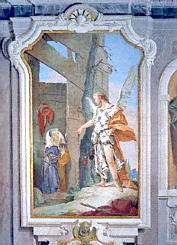
. |
|
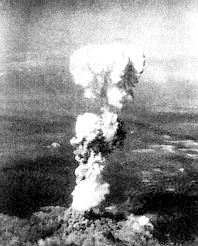 |
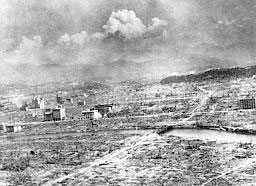
Mr. Sitchin
compares the destruction of Sodom and Gomorrah to the
Nuclear destruction of Hiroshima (above) and Nagasaki
(below)
.
|
|
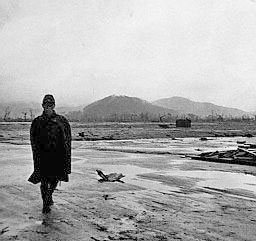 |
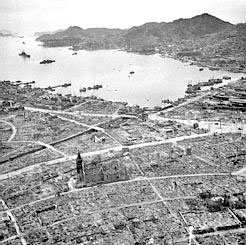 |
|
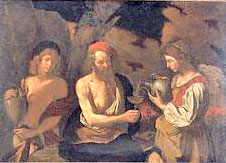
After Sodom
and Gomorrah were destroyed,
Lot and his
daughters believed they were the only remnants on
Earth.... |
|
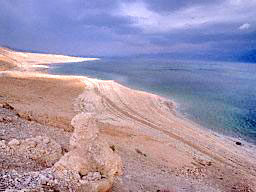
|
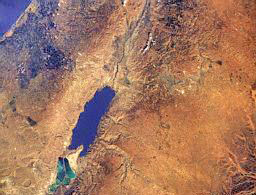
Dead Sea.
The southern tip "The Tongue" is believed to be the site
where Sodom and Gomorrah lie buried. The water of
springs, to this day, are still contaminated with
radioactivity. |
|
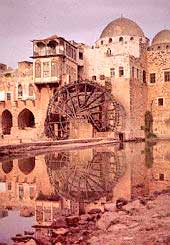 |
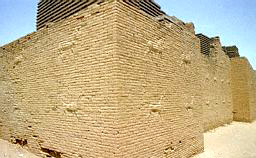
Hama Right),
a city Marduk passed by, on his way from Asia Minor to
Mesopotamia. His dream was to restore Babylon, (one of
its ruins, above), but Marduk had many oponents...
.
|
|
It was the
"Wars of Gods and Men"
which brought about the
destruction of the Spaceport at Sinai |
|
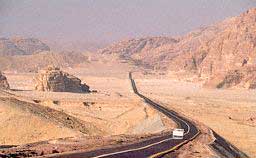
A Highway on
Sinai today
|
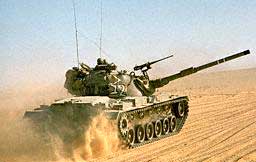
Mr. Sitchin
comments that the flat Sinai plain is as good today for
tanks as it was for the Anunnaki’s shuttlecraft.
|
|
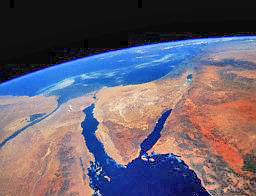
The scar
made in the face of the Earth that awesome day can still
be seen.....
its features can only be seen from space,
revealed in recent years by satellites.
No scientist has
hitherto offered an explanation. |
|
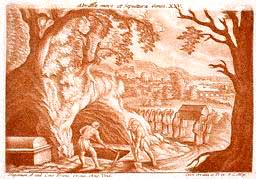
Abraham
never returned to Sinai. His sons Isaac and Ishmael
buried him near Mamre. |
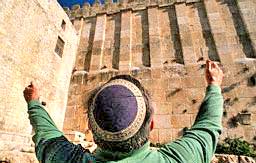
A man from
Hebron praying in front of Abraham’s tomb
|
"Where are the remains
of Sodom and Gomorrah today? Ancient Greek and Roman geographers
reported that the once fertile valley of the five cities was
inundated following the catastrophe. Modern scholars believe that
the "upheavaling" described in the Bible caused a breach in the
southern shore of the Dead Sea, letting its water pour through to
submerge the low-lying region to the south. The remaining portion of
what was once the southern shore became the feature figuratively
called by the natives el-Lissan ("The Tongue"), and the once
populated valley with its five cities became a new, southern part of
the Dead Sea still bearing the local nick-name "Lot’s Sea...."
"The ancient reports have been confirmed in modern times by various
researchers, beginning with an exhaustive exploration of the area in
the 1920s by a scientific mission sponsored by the Vatican’s
Pontifical Biblical Institute (A. Mallon, Voyage d’Exploration au
sud-est de la Mer Morte). Leading archaeologists, such as W.F.
Albright and P. Hartland, discovered that settlements in the
mountains around the region were abruptly abandoned in the
twenty-first century B.C. and were not reoccupied for several
centuries thereafter. And to this very day, the water of springs
surrounding the Dead Sea has been found to be contaminated with
radioactivity, "enough to induce sterility and allied afflictions in
any animals and humans that absorbed it over a number of years" (I.M.
Blake, "Joshua’s Curse and Elisha’s Miracle" in
The Palestine
Exploration Quarterly).
"The cloud of death, rising in the skies from the cities of the
plain, frightened not only Lot and his daughters but also Abraham,
and he did not feel safe even in the Hebron Mountains, some fifty
miles away. We are told by the Bible that he pulled up his
encampment and moved further away westward, to reside at Gerar.
"Also, at no time thereafter did he venture into the Sinai. Even
years later, when Abraham’s son Isaac wanted to go to
Egypt on
account of a famine in Canaan, "Yahweh appeared unto him and said:
’Go not down to Egypt; dwell in the land which I will show thee.’"
The passage through the Sinai peninsula was apparently still unsafe.
But why?
"The destruction of the cities of the plain, we believe,
was only a
sideshow: concurrently, the Spaceport in the
Sinai peninsula was
also obliterated with nuclear weapons, leaving behind a deadly
radiation that lingered on for many years thereafter.
"The
main nuclear target was in the Sinai peninsula; and the real
victim, in the end, was Sumer itself.
"The
Year of Doom - 2024 B.C. - was the sixth year of the reign of
Ibbi-Sin, the last king of Ur, but to find the reasons for the
calamity, explanations of its nature, and details of its scope, we
will have to study the records of those fateful years back from the
time of that war.
"Having failed in their mission and twice humiliated by the hand of
Abraham - once at Kadesh-Barnea, then again near
Damascus - the
invading kings were promptly removed from their thrones. In
Ur, Amar-Sin
was replaced by his brother Shu-Sin, who ascended the throne to find
the great alliance shattered and Ur’s erstwhile allies now nibbling
at her crumbling empire.
"Although they, too, had been discredited by the
War of the Kings, Nannar and Inanna were at first the gods in whom
Shu-Sin had put his
trust. It was Nannar, Shu-Sin’s early inscriptions stated, who had
"called his name" to kingship; he was "beloved of Inanna" and she
herself presented him to Nannar.
"....But all this was insufficient to hold together the Sumerian
empire, and Shu-Sin soon turned to greater gods for succor.
"Judging from the date formulas - annual inscriptions, for royal as
well as commercial and social purposes, in which each successive
year of a king’s reign was designated by the major event of the year
- Shu-Sin, in the second year of his reign, sought the favors of
Enki by constructing for that god a special boat that could navigate
the high seas all the way to the Lower World. The third year of
reign was also one of preoccupation with the pro-Enki alignment.
Little else is known of this effort, which could have been a
roundabout way of pacifying the followers of Marduk and Nabu; but
the effort evidently failed, for the fourth and fifth years
witnessed the building of a massive wall on the western frontier of
Mesopotamia, specifically aimed at warding off incursions by the
"Westerners," followers of Marduk.
"....Desperately
Shu-Sin sought acceptance, confirmation that he was
"the king whom Enlil, in his heart, had chosen." But
Enlil was not
there to answer; only Ninlil, Enlil’s spouse, who remained in
Nippur,
heard Shu-Sin supplications. Responding with compassion "so as to prolongue the well-being of
Shu-Sin, to extend the time of his
crown," she gave him a "weapon which with radiance strikes down... whose awesome flash reaches the sky."
"....There was one final effort to entice
Enlil back to Sumer, to
find shelter under his aegis. On the apparent advice of Ninlil,
Shu-Sin
built for the divine couple "a great touring boat, fit for the
largest rivers... He decorated it perfectly with precious
stones," outfitted it with oars made of the finest wood,
punting
poles and an artful rudder, and furnished it with all manner of
comfort including a bridal bed. He then, "placed the touring boat in
the wide basin facing Ninlil’s House of Pleasure."
"The nostalgic aspects struck a chord in
Enlil’s heart, for he had
fallen in love with Ninlil, when she was still a young nurse....
"....The sentimental journey, however, was only a brief interlude.
Seemingly (part of the tablet is missing), there had been foul play,
and an "evil inscription was found on an effigy on the boat,
"intended perhaps to place a curse on Enlil and Ninlil.... All other
evidence suggests that he again left Nippur, this time apparently
taking Ninlil with him.
"Soon thereafter - February 2031 B.C. by our calendar - the Near
East was awed by a total lunar eclipse, which blacked out the moon
during the night for its full course from horizon to horizon. The
oracle priests of Nippur could not allay Shu-Sin’s anxiety: it was,
they said in their written message, an omen "to the king who rules
the four regions: his wall will be destroyed, Ur will become
desolate."
And so it was for Shu-Sin, and his successor, the last,
Ibbi-Sin.
Marduk (to whom the omens had referred to) returned to Babylon for
the second time.
"The twenty-four fateful years - since
Abraham left Harran, since
Shulgi was replaced to the throne, since Marduk’s exile among the
Hittites had begun - have all converged in that Year of Doom,
2024
B.C. Having followed the separate , but interconnected, biblical
tale of Abraham and the fortunes of Ur and its last three kings, we
will now follow in the footsteps of Marduk.
"The tablet on which
Marduk’s autobiography is inscribed (from which
we have already partly quoted) continues to relate his return to
Babylon after the twenty-four years of sojourn in the
Land of Hatti.
"....Then, in that twenty-fourth year, he received a favorable omen.
"....His wish, Marduk continued, was to bring peace and prosperity
to the land, "chase away evil and bad luck... bring motherly love
to Mankind." But it all came to naught: Against his city,
Babylon,
an adversary god "his wrath had brought." The name of this adversary
god is stated at the very beginning of a new column of the text; but
all that has remained of it is the first syllable: "Divine NIN-."
The reference could have been only to Ninurta.
"....We can pick up some
of the missing threads from the third tablet of the Khedorlaomer
Texts. In spite of its enigmatic aspects, it paints a picture of
total turmoil, with adversary gods marching against each other at
the head of their human troops: the Amorite supporters of Marduk
swooped down the Euphrates valley toward Nippur, and
Ninurta
organized Elamite troops to fight them.
"As we read and reread the record of those trying times, we find
that to accuse an enemy of atrocities is not a modern innovation.
The Babylonian text - written, we must keep bearing in mind, by a
worshiper of Marduk - attributes to the elamite troops, and to them
alone, the desecration of temples, including the shrines of Shamash
and Ishtar. The Babylonian chronicler goes even farther: he accuses
Ninurta of falsely blaming on the followers of Marduk the
desecration of Enlil’s Holy-of Holies in Nippur, thereby provoking
Enlil to take sides against Marduk and his son Nabu.... but it was
not Marduk (who desecrated the Ekur), it was Erra (Nergal/Erra):
Erra, the pitiless one,
entered the sacred precinct.
He stationed himself in the sacred precinct,
he beheld the Ekur.
His mouth he opened, he said to his young men:
"Carry off the spoil of Ekur,
take away its valuables,
destroy its foundation,
break down the enclosure of the shrine.
"When Enlil, "loftily enthroned," heard that his temple had been
destroyed, its shrine defiled, that "in the holy of holies the veil
was torn away," he rushed back to Nippur. "Riding in front of him
were gods clothed with radiance"; he himself "set off brilliance
like lightning" as he came down from the skies; "he made the holy
place shake" as he descended to the sacred precinct. Enlil then
addressed himself to his son, "the Prince Ninurta," to find who had
defiled the sacred place. But instead of telling the truth, that it
was Erra, his ally, Ninurta pointed the accusing finger to
Marduk
and his followers...
"Describing the scene, the Babylonian text asserts that
Ninurta was
acting without the required respect on meeting his father: "not
fearing for his life, he removed not his tiara." To Enlil "evil he
spoke... there was no justice; destruction was conceived." and so
provoked, "Enlil against Babylon caused evil to be planned."
"In addition to "evil deeds" against Marduk and
Babylon, an attack
against Nabu and his temple Ezida in Borsippa was also planned. But
Nabu managed to escape westward, to the cities faithful to him near
the Mediterranean Sea.
"....there follow verses in the
Babylonian text that have a direct
parallel in the biblical tale of the destruction of Sodom and
Gomorrah.
"....The picture that can be gathered from the
biblical and
Babylonian texts of the cataclysm that engulfed the ancient Near
East in the time of Abraham is much fully detailed in
the Erra Epic
(to which we have already referred earlier)....
"The
Erra Epic not only explains the nature and causes of the
conflict that had led to the unleashing of the Ultimate Weapon
against inhabited cities and the attempt to annihilate a god (Nabu)
believed hiding therein. It also makes clear that such an extreme
measure was not taken lightly.
"We know from several other texts that the great gods, at that time
of acute crisis, were sitting in a continuous Council of War,
keeping constant communication with Anu: "Anu to Earth the words was
speaking, Earth to Anu the words pronounced." The Erra Epic adds the
information that before the awesome weapons were used, one more
confrontation had taken place between Nergal/Erra and Marduk, in
which Nergal used threats to persuade his brother to leave
Babylon
and give up his claims to Supremacy.
"But this time, persuasion failed; and back at the
Council of the
Gods, Nergal voiced the recommendation for the use of force to
dislodge Marduk.... An especially violent argument developed between
Enki and his son Nergal, in which Enki stood by his firstborn son:
"Now that Prince Marduk has arisen, now that the people for the
second time have raised his image, why does Erra continue his
opposition?" Enki asked. Finally, losing his patience,
Enki shouted
at Nergal to get out of his presence.
"Leaving in a huff,
Nergal returned to his domain. "Consulting with
himself," he decided to unleash the awesome weapons: "The lands I
will destroy, to a dust-heap make them; the cities I will upheaval,
to desolation turn them; the mountains I will flatten, their animals
make disappear; the seas I will agitate, that which teems in them I
will decimate; the people I will make vanish, their souls shall turn
to vapor, none shall be spared. . . . "
"....It was
Gibil (whose domain in Africa adjoined that of
Nergal)
"these words to Marduk did speak" in regard to the "seven awesome
weapons which by Anu were created... The wickedness of those
seven against thee is being laid," he informed Marduk.
"Alarmed,
Marduk inquired of Gibil where the awesome weapons were
kept.... To which Gibil revealed that they were hidden underground:
Those seven, in the mountain they abide,
in a cavity inside the earth they dwell.
From this place with a brilliance they will rush forth,
From Earth to Heaven, clad with terror.
"But where exactly is this place?
Marduk asked again and again; and
all Gibil could say was that "even the wise gods, to them it is
unknown."
"Now Marduk rushed to his father
Enki with the frightening report.
"....Soon the gods were back in council, for even Enki knew not the
exact hiding place of the Ultimate Weapons. To his surprise, not all
the other gods were as shocked as he was. Enki spoke strongly
against the idea, urging steps to stop Nergal, for the use of the
weapons, he pointed out, "the lands would make desolate, the people
will make perish." Nannar and Utu wavered as Enki spoke; but
Enlil
and Ninurta were for decisive action. And so, with the Council of
the Gods in disarray, the decision was left to Anu.
"When
Ninurta finally arrived to the Lower World with word of
Anu’s
decision, he found out that Nergal had already ordered the priming
of "the seven awesome weapons" with their "poisons" - their
nuclear
warheads. Though the Erra Epic keeps referring to
Ninurta by the
epithet Ishum ("The Scorcher"), it details in great detail how
Ninurta had made clear to Nergal/Erra that the weapons could be used
only against specifically approved targets; that before they could
be used, the Anunnaki gods at the selected sites and
the Igigi gods
manning the space platform and the shuttlecraft had to be forewarned;
and, last but not least, mankind had to be spared, for "Anu, lord of
the gods, on the land had pity."
"....The words of
Ninurta finally swayed Nergal. "He heard the words
spoken by Ishum [Ninurta]; the words appealed to him as fine oil."
Agreeing to leave alone the seas, to leave Mesopotamia out of the
attack, he formulated a modified plan: the destruction will be
selective; the tactical aim will be to destroy the cities where
Nabu
might be hiding; the strategic aim will be to deny to Marduk his
greatest prize - the Spaceport, "the place from where the Great Ones
ascend."
"....So, with one nuclear blow, the
Spaceport was obliterated, the
mount within which its controls were hidden smashed, the plain that
served its runways obliterated... It was a destructive feat, the
written record attests, performed by Ninurta (Ishum).
"Now it was the turn of
Nergal (Erra) to give vent to his vow of
vengeance. Guiding himself from the Sinai peninsula to the
Canaanite
cities by following the King’s Highway, Erra
upheaval them. The
words employed by the Erra Epic are almost identical to those used
in the biblical tale of Sodom and Gomorrah.
"The verses that follow may well describe the creation of the new
southern portion of the Dead Sea, by breaking through its southern
shoreline, and the elimination of all marine life therein:
He dug through the sea,
its wholeness he divided.
That which lives in it,
even the crocodiles
he made wither.
As with fire he scorched the animals,
banned its grain to become as dust.
"....The deed performed by the two gods
Ninurta and Nergal, when the
Anunnaki guarding the Spaceport, forewarned, had to escape by
"ascending to the dome of heaven," was recalled in a Babylonian text
in which one king recalled the momentous events that had taken place
"in the reign of an earlier king."
"....Thus was the
Spaceport, the prize over which so many Wars of
the Gods had been fought, obliterated....
"The great place was never to be seen again.... but the
scar made on
the face of Earth that awesome day can still be seen - to this very
day! It is a vast scar, so vast that its features can be seen only
from the skies - revealed only in recent years as satellites began
to photograph the Earth. It is a scar for which no scientist has
hitherto offered an explanation.
"....The limestone mountains loom white on the horizon, but where
the great central plain adjoins the immense scar in the Sinai, the
hue of the plain - black - stands out in sharp contrast to the
surrounding whiteness.
"Black is not a natural hue in the
Sinai peninsula, where the
whiteness of the limestone and the redness of the sandstone combine
to dazzle the eye with hues raging from bright yellow to light gray
and dark brown but nowhere the black which comes in nature from
basalt stones.
"Yet here, in the central plain north-northwest of the enigmatic
giant scar, the soil’s color has a black hue. It is caused - as our
photograph clearly shows - by millions upon millions of bits and
pieces of blackened rock, strewn as by a giant hand over the whole
area.
"....No explanation - unless one reads the verses of the ancient
texts and accepts our conclusion that in the days of Abraham,
Nergal
and Ninurta wiped out the Spaceport that was there
with nuclear
weapons:
"That which was raised towards
Anu to launch they caused to
wither, its face they made fade away, its place they made desolate."
"And the Spaceport, even the
Evil Cities, were no more.
"Far away to the west, in Sumer itself,
the nuclear blasts and their
brilliant flashes were neither felt nor seen. But the deed done by
Nergal and Ninurta had not gone unrecorded, for it turned out to
have had a most profound effect on Sumer, its people, and its very
existence.... The nuclear explosion gave rise to an immense wind, a
radioactive wind which began as a whirlwind.... and then the
radioactive whirlwind began to spread and move westward with the
prevailing winds blowing from the Mediterranean.... Sumer
itself
became the ultimate nuclear victim.
"The catastrophe that befell
Sumer at the end of Ibbi-Sin’s sixth
year of reign is described in several
Lamentation Texts - long poems
that bewail the demise of the majestic Ur and the other centers of
the great Sumerian civilization.
"....Invasion, war, killing - all those were well known to mankind
by then; but, as the lamentations texts clearly state, this one was
unique and never experienced before:
On the Land (Sumer) fell a calamity,
one unknown to man:
One that had never been seen before,
one that could not be withstood.
The people, terrified, could hardly breathe;
the Evil Wind clutched them,
does not grant them another day . . .
Mouths were drenched in blood,
heads wallowed in blood . . .
The face was made pale by the Evil Wind.
"The source of the unseen death was a cloud that appeared in the
skies of Sumer and "covered the land as a cloak, spread over it like
a sheet." Brownish in colour, during the daytime "the sun in the
horizon it obliterated with darkness." At night, luminous at its
edges ("Girt with dread brilliance it filled the broad earth") it
blocked out the moon: "the moon at its rising it extinguished...."
"It was not, however, a natural phenomenon. It was "a great storm
directed from Anu . . . it hath come from the heart of Enlil." The
product of the seven awesome weapons....
"Though the people were baffled,
the gods knew the cause of the Evil
Wind:
An evil blast heralded the baleful storm,
An evil blast the forerunner
of the baleful storm was;
Mighty offspring, valiant sons
were the heralds of the pestilence.
"The two valiant sons -
Ninurta and Nergal - unleashed "in a single
spawning" the seven awesome weapons created by Anu, "uprooting
everything, upheavaling everything" at the place of the blast. The
ancient descriptions are as vivid, as accurate as modern eyewitness
descriptions of an atomic explosion: As soon as the "awesome
weapons" were launched from the skies, there was an immense
brilliance: "they spread awesome rays towards the four points of the
earth, scorching everything like fire," one text stated; another, a
lamentation over Nippur, recalled "the storm, in a flash of
lightning created." An atomic mushroom - "a dense cloud that brings
gloom" - then rose to the sky; it was followed by "rushing wind
gusts.... a tempest that furiously scorches the heavens." Then the
prevailing winds, blowing from west to east, began to spread toward
Mesopotamia: "the dense clouds that bring gloom from the sky, that
bear the gloom from city to city."
"Not one, but several, texts attest that the
Evil wind, bearing the
cloud of death, was caused by gigantic explosions on a day to
remember.
"....The lamentation texts identified the site of the awesome blasts
as "in the west," near "the breast of the sea" - a graphic
description of the curving Mediterranean coast at the Sinai
peninsula - from a plain "in the midst of the mountains," a plain
that became a "Place of No Pity." It was a place that served before
as the Place of Launching, the place from where the gods ascended
toward Anu. In addition, a mount also featured in many of these
place identifications. In
the Erra Epic, the mount near "the place
from which Great Ones ascend" was called the "Mount Most Supreme";
in one of the lamentations it was called the "Mount of Houling
Tunnels." This last epithet brings to mind the descriptions, in the
Pyramid Texts, of the tunneled mount with sloping underground
passages, to which Egyptian Pharaohs journeyed in search of an
afterlife. In
The Stairway to Heaven we have identified it with the
mount Gilgamesh had reached in his journey to the place of the
Rocketships, in the Sinai peninsula.
"....The
Uruk Lament vividly describes the confusion among both the
gods and the populace. Stating that Anu and Enlil had overruled
Enki
and Ninki when they "determined the consensus" to employ the
nuclear
weapons, the text asserts that none of the gods anticipated the
awesome outcome: "The great gods paled at its immensity" as they
witnessed the explosion's "gigantic rays reach up to heaven [and]
the earth trembled to its core."
"....A breathtaking description of the fear and confusion, among
gods and men alike, as the Evil Wind approached is given in
The Uruk
Lament text, which was written years later as the time of
Restoration came.
"....Ninki, we learn from
The Eridu Lament, flew away from her city
to a safe haven in Africa: "Ninki, its great lady, flying like a
bird, left her city." But Enki left Eridu only far enough to get out
of the Evil Wind’s way, yet near enough to see its fate: its lord
stayed outside his city . . . Father Enki stayed outside the city .
. . for the fate of his harmed city he wept with bitter tears." Many
of his loyal subjects followed him, camping on its outskirts. For a
day and a night they watched the storm "put its hand" on
Eridu....
Enki surveyed Eridu.... Those who were saved addressed to him a
lament.... and they kept on asking whence should they go, what
should they do. But though the Evil Wind had passed, the place was
still unsafe.... "Forsaking the house of Eridu,"
Enki then led
"those who have been displaced from Eridu" to the desert, "towards
an inimical land"; there he used his scientific powers to make "the
foul tree" edible.
"From the northern edge of the Evil Wind’s side swath, from
Babylon,
a worried Marduk sent his father, Enki, an urgent message as the
cloud of death neared his city. "What am I to do?" he asked.
Enki’s
advice, which Marduk then related to his followers, was that those
who could should leave the city - but go only north; and in line
with the advice given by the two emissaries to Lot, the people
fleeing Babylon were warned "neither to turn nor to look back...."
If escape was not possible, Enki advised hiding underground: "Get
thee into a chamber below the earth, into a darkness," until the
Evil Wind was gone.
Mr. Sitchin continues with a series of
lamentations from other gods.
But the fact was that Sumer had been affected not by the blast, but
by the Evil Wind, and...
"The desolation of
Sumer was complete."
Return to
The Wars of Gods and Men
or
Return to Ancient Atomic Warfare
|



































